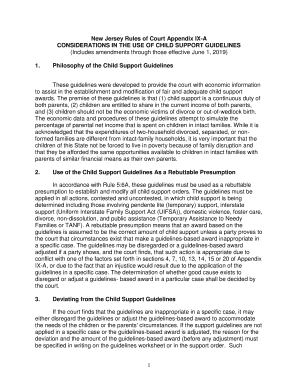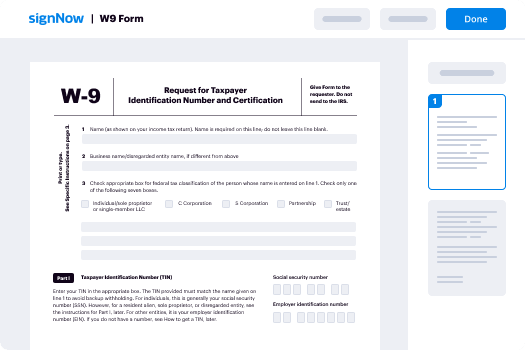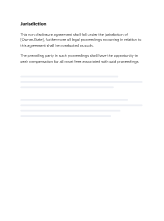1
New Jersey Rules of Court Appendix IX -A
CONSIDERATIONS IN THE USE OF CHILD SUPPORT GUIDELINES
(Includes amendments through those effective June 1, 2019 )
1. Philosophy of the Child Support Guidelines
These guidelines were developed to provide the court with economic information
to assist in the establishment and modification of fair and adequate child support
awards. The premise of these guidelines is that (1) child support is a continuous duty of
both parents, (2) children are entitled to share in the c urrent income of both parents,
and (3) children should not be the economic victims of divorce or out -of -wedlock birth.
The economic data and procedures of these guidelines attempt to simulate the
percentage of parental net income that is spent on children in intact families. While it is
acknowledged that the expenditures of two -household divorced, separated, or non -
formed families are different from intact -family households, it is very important that the
children of this State not be forced to live in pover ty because of family disruption and
that they be afforded the same opportunities available to children in intact families with
parents of similar financial means as their own parents.
2. Use of the Child Support Guidelines As a Rebuttable Presumption
In a ccordance with Rule 5:6A, these guidelines must be used as a rebuttable
presumption to establish and modify all child support orders. The guidelines must be
applied in all actions, contested and uncontested, in which child support is being
determined inclu ding those involving pendente lite (temporary) support, interstate
support (Uniform Interstate Family Support Act (UIFSA)), domestic violence, foster care,
divorce, non -dissolution, and public assistance (Temporary Assistance to Needy
Families or TANF). A rebuttable presumption means that an award based on the
guidelines is assumed to be the correct amount of child support unless a party proves to
the court that circumstances exist that make a guidelines -based award inappropriate in
a specific case. The gui delines may be disregarded or a guidelines -based award
adjusted if a party shows, and the court finds, that such action is appropriate due to
conflict with one of the factors set forth in sections 4, 7, 10, 13, 14, 15 or 20 of Appendix
IX -A, or due to the fact that an injustice would result due to the application of the
guidelines in a specific case. The determination of whether good cause exists to
disregard or adjust a guidelines - based award in a particular case shall be decided by
the court.
3. Deviati ng from the Child Support Guidelines
If the court finds that the guidelines are inappropriate in a specific case, it may
either disregard the guidelines or adjust the guidelines -based award to accommodate
the needs of the children or the parents' circumsta nces. If the support guidelines are not
applied in a specific case or the guidelines -based award is adjusted, the reason for the
deviation and the amount of the guidelines -based award (before any adjustment) must
be specified in writing on the guidelines w orksheet or in the support order. Such
2
findings clarify the basis for the support order if appealed or modified in the future. If the
guidelines are found to be inapplicable in a particular case, the court should consider
the factors set forth in N.J.S.A. 2A:34 -23 or N.J.S.A. 9:17 -53 when establishing the child
support award.
4. The Income Shares Approach to Sharing Child -Rearing Expenses
New Jersey statutes and case law provide that both parents are responsible for
the financial needs of their children. In intact families, the income of both parents is
pooled and spent for the benefit of all household members including the children. Each
parent's contribution to the combined income of the family represents their relative
sharing of household expenses. For example, if the parents have equal incomes, they
are assumed to share all expenditures for the family equally (50%). This same income
sharing principle is used to determine how the parents will share a child support award.
In dissolved or non -formed f amilies, however, the parents share only the expenses for
the child (i.e., the Appendix IX -F support schedules are based on the marginal or added
cost of a child or children to an adult couple). In sole -parenting situations, the custodial
parent's share o f the child -rearing expenses is assumed to be spent directly on the child
through daily living expenses. The non -custodial parent's share of child - rearing costs
represents the support order that is paid to the custodial parent for the benefit of the
child . In situations involving PAR Time (formerly referred to as visitation), both parents
make direct expenditures for the child while the child resides in their homes. To
accommodate duplicated and shifting expenses associated with a child who shares time
wit h parents who live separately, the Appendix IX -F sole -parenting awards may need to
be adjusted to reflect each parent's assumed level of marginal spending on the child.
5. Economic Basis for the Child Support Guidelines
At the foundation of the child sup port guidelines are estimates of what parents in
intact families spend on their children. Determining the cost of raising a child is difficult
because most goods and services purchased by families are shared by adults and
children. Economists estimate that approximately 65% of household spending is for
pooled items (e.g., a car, a washing machine, or a box of laundry detergent used in
common by all household members). Even for goods that are privately consumed (e.g.,
clothing, food), expenditure surveys are not detailed enough to link individual household
members (adults or children) to a particular expenditure. Together, pooled and privately
consumed goods account for about 90% of total household expenditures. Since most
expenditures on children cannot be o bserved directly, economists use an indirect
method of determining child -rearing costs known as marginal -cost estimation. Marginal -
cost estimation attempts to find the added cost of a child to a family by comparing the
expenditures of families considered e qually well -off economically and have different
numbers of children. For example, if two families (one with and one without a child) are
equally well -off, the additional expenses of the family with a child are assumed to be the
marginal cost of the child.
Selecting a Standard of Well -Being - Before estimating the marginal cost of
children, a standard of well -being must be defined. Different marginal cost estimation
3
methods use different standards of well -being. Although several standards have been
used i n the past, no consensus has emerged as to which provides the most credible
result. Two of the most widely used marginal -cost estimation methods, Rothbarth and
Engel, employ the standards of well -being described below.
Engel - The standard of well -being i s the proportion of household income
spent on food. Thus, if two families spend the same percentage of their
income on food, they are considered equally well -off.
Rothbarth - This standard of well -being is based on how parents adjust
their spending on adult goods due to the presence of a child. In other
words, well -being is measured by comparing excess -income (i.e., after
necessary expenditures for the family) available to p urchase adult goods
such as adult clothing, alcohol, tobacco, and entertainment.
Consumer Expenditure Data - Once an estimation technique is chosen, the
household expenditure data to which it is applied must be selected. Typically,
economists use data fro m the Consumer Expenditure Survey (CEX). The CEX is the
most detailed source of national data on household expenditures and how they vary by
family composition, size, geographic location and socioeconomic characteristics. The
CEX collects expenditure infor mation for hundreds of household consumption items
including food, housing, clothing, transportation, education, child care, health care, and
entertainment. The CEX is a cross -sectional survey designed to represent the civilian,
non -institutional populatio n in the United States. Approximately 5,000 families
participate in the CEX each quarter. CEX results are published annually, however, the
results are generally three years old by the time they are available for public use. The
CEX is considered the best a vailable source of information for determining the cost of
children using marginal -cost estimation techniques.
The Betson Analysis - In September 1990, Dr. David Betson of the University of
Notre Dame published child -rearing estimates based on his analysi s of pooled CEX
data from 1980 through the first quarter of 1987, a variety of estimation techniques, and
alternative definitions of the standard of well -being. As did previous studies, Dr.
Betson's analysis resulted in a wide range of estimates of expendi tures on children. Dr.
Betson, like other economists, believes that the true range of marginal expenditures on
children lies at some interval between the Engel and Rothbarth estimates. The Engel
estimates, which are close to per capita (i.e., equal shares) , clearly overstate the
marginal cost of children and, thus, represent the upper bound of spending on children.
Economists know that the Engel estimates are incorrect, but do not have the same
information about the Rothbarth estimates. Thus, the Rothbarth estimates may
represent the true level of marginal spending on children or the theoretical lower bound
of that spending. Dr. Betson concluded that the Rothbarth method produced the best
set of estimates on the marginal cost of children because it has the l east empirical flaws
and those that do exist have a minimal effect on the resulting estimates.
Estimating Spending on Children - The CEX does not have a direct measure of
4
spending on children, so the expenditures on children are measured indirectly. The c ost
of raising children is estimated by comparing total spending in households without
children to total spending in households with one, two, and three children in all income
categories covered by the tables. Although this may be an indicator of the margi nal
increase in household spending when children are added, it does not give a complete
picture since income constraints may also force adults to spend less on themselves to
share what income is available with their child(ren). To measure the impact childr en
make on adult household spending, economists Michael and Lazear have ascertained
that measuring the change in expenditures on adult clothing gives the best estimate of
expenditures on children in the household. This particular "estimator," which is a
de rivative of the Rothbarth methodology adopted to current use by Dr. William Rodgers,
III, Chief Economist of the John J. Heldrich Center for Workforce Development, Edward
Bloustein School of Planning and Public Policy, at Rutgers University, is along with the
marginal increases in overall household spending, analyzed to arrive at the overall cost
of child rearing as reflected in the awards table. The CEX data is also adjusted to
account for the variety of educational levels, ethnic backgrounds, and other fa ctors
specific to the population of New Jersey.
Development of Child Support Award Schedules - Dr. Rodgers' 2012 study
estimates parental expenditures on one, two, and three children as a percentage of total
household outlays. To do this, Rodgers uses the estimation method developed in the
Lazear and Michael treatise (1988) and transforms the Rothbarth parameters into a
schedule of child support obligations by using the following steps:
a. converting child -related spending as a proportion of consumption t o a
proportion of net income;
b. updating estimates to 2011;
c. adjusting the schedule to reflect New Jersey's higher cost of living as
measured by the "Consumer Price Index – All Urban Consumers"
(CPI -U);
d. deducting the cost of child care and unreimburs ed health care
expenses that exceed $250 per child per year (these expenses are
added to the basic obligation);
e. extrapolating the estimates to families with four, five, and six children;
f. computing marginal proportions between income intervals so that the
support schedule can be constructed in ten dollars increments;
g. using the Rothbarth and marginal proportions to create the relationship
between support obligations and combined net weekly income; and
h. using median regression to smooth (remove rema ining kinks/discrete
jumps) the relationship.
6. Economic Principles Included in the Child Support Guidelines
a. There is no absolute cost of raising children. The cost of raising children is
inferred from the amount that parents' spend on their children. A child's marginal cost is
the amount of spending above what the parents would spend if they did not have a
child.
5
b. Larger households have lower per -person costs due to economies of
scale and the sharing of family goods (i.e., unit prices decrease as q uantities and
sharing increase).
c. Total spending on children increases with family size but at a decreasing
rate. Support awards increase with the number of children in the family.
d. When a family's total outlays rise, child -related spending increases roughly
in the same proportion. In the Rodgers study's analysis, as one moves from the lowest
to highest of the 22 income intervals, the average increase in total outlays is 7%, 6%,
and 7% for one child, two children, and three children. The comparable av erage
increases in the expenditures on children are 7%, 7%, and 9%.
e. As a family's income increases, child -related expenditures increase
because parents use a portion of their disposable income to improve their children's
quality of life. From the Lazea r and Michael model, the change (derivative) in child -
related expenditures with respect to family income has two components. The second
portion of the derivative is the positive impact that income has on total expenditures.
f. Child -related expenditures a s a percentage of family consumption are
relatively constant across most of the income scale.
g. As income increases, total family consumption spending declines as a
proportion of net income since income items such as savings, personal insurance, and
gift s increase with family income. Families at lower level of the income ladder have
consumption spending that may exceed 100% of net income. In contrast, high - income
families may spend 60% to 75% of net income on consumption items.
h. As a family's income i ncreases, child -related expenditures as a proportion
of family income decline, even though these expenditures as a percentage of a family's
consumption spending remain fairly constant. The difference between spending as a
proportion of family income and a proportion of consumption is due to the effect of
income taxes, savings, and charitable contributions. Income allocated to these items is
not available for consumption spending.
i. Due to economies of scale, the sharing of family goods and the
redistribut ion of adult spending, as the number of children increases, the additional cost
of each child has a less than proportionate increase. Dr. Rodgers estimates that child -
related expenditures for two children are less than twice as much as child -related
expen ditures for one child. For two children, the average cost across the 22 income
intervals is 1.7 more than one child. Also, the child -related expenditures for three
children are less than three times as much as one child. This study average is 2.2 more
than one child. These estimates lie in the range of those reported in the 2004 Policy
Studies report for New Jersey.
6
7. Assumptions Included in the Child Support Guidelines
a. Intact Family Spending Patterns as the Standard for Support Orders -
Support guidel ines based on spending patterns of intact families provide an adequate
level of support for children. Child -rearing expenditures of single parents provide little
guidance for setting adequate child support awards since single -parent households
generally ha ve less money to spend compared with intact families. The fact that single
parents actually do spend less income on children compared with two -parent families
does not mean that they should spend less if the other parent has the means to
increase total spe nding on the children through support payments. Also, the level of
spending by single parents on their children has no relation to adequacy or the needs of
the children but is a function of the total amount of income available to those parents.
b. Standar d of Living - Although these support guidelines attempt to
approximate the same level of marginal spending on children before divorce or
separation, the resulting child support awards do not guarantee that the children's
standard of living will remain the same if one of those events occurs. Usually, the
children's standard of living will decline since the child support award (based on
marginal spending) is being added to a much smaller level of base household
expenditures. Less total money is available in t he primary household of the child after
divorce or separation since the other parent's income is no longer available. Less
money means a decline in household expenditures which results in a lower standard of
living. Additionally, some economies of scale a re lost when one parent leaves the
household.
c. Marginal -Cost Estimation - For determining child support obligations,
marginal -cost estimation techniques, which provide the additional cost of children based
on intact - family spending patterns, are more a ppropriate than average -cost methods
that divide spending between all family members equally (per capita).
d. The Rothbarth Marginal Cost Estimator - The Rothbarth marginal cost
estimation techniques (e.g., Betson and Lazear and Michael) provide the most accurate
estimates of parental expenditures on children in dual -parent families. Dr. Rodgers'
2012 analysis of the 2000 to 2011 micro data of the Consumer Expenditure Survey
provides the most current and reliable estimates of child -related expenditures in dual -
parent families.
e. National versus New Jersey Spending on Children - Because the
Rothbarth estimates are for the U.S. and it is well known that New Jersey's income
distribution is very different from the U.S income distribution, Dr. Rodgers uses U .S.
Census data to equate the income of New Jersey and U.S families and constructs
proportions to smooth the schedule or remove discrete jumps in obligation as net
income rises. This follows the same principle as in the 2004 Policy Studies Report for
New J ersey. The 2010 U.S. and New Jersey income distribution in the American
Community Survey was used to adjust the Rothbarth estimates.
7
f. NCP/PAR Time - The awards in the support schedules represent spending
on children by intact families. In an intact famil y, the children reside in one household
and no NCP/PAR Time is needed. This is similar to child support actions in which one
parent has sole physical custody of a child and there is no NCP/PAR Time. The awards
in the Appendix IX -F support schedules represe nt situations in which the child is with
the custodial parent 100% of the time. Although the Appendix IX -F awards are not
reduced for NCP/PAR Time, they may be adjusted, if these factors are present in a
specific case, through worksheet calculations. For further information and assumptions
related to NCP/PAR Time adjustments and their related assumptions, see paragraphs
13 and 14 respectively.
g. Effect of a Child's Age - Dr. Rodgers' 2012 study does not provide
estimates on child -rearing expenditures by children's age groups. The Appendix IX -F
awards represent the average cost of raising a child from age zero through 17 years
(i.e., the total marginal cost averaged over 18 years). Studies have shown that
expenditures are higher than the average for teen -aged children and lower than the
average for preteen children.
h. Self -Support Reserve - The self -support reserve is a factor in calculating a
child support award only when one or both of the parents have income at or near the
poverty level. The self -support reserve is 105% of the U.S. poverty guideline for one
person. I t attempts to ensure that the obligor has sufficient income to maintain a basic
subsistence level and the incentive to work so that child support can be paid. A child
support award is adjusted to reflect the self -support reserve only if payment of the chil d
support award would reduce the obligor's net income below the reserve and the
custodial parent's (or the Parent of the Primary Residence's) net income minus the
custodial parent's share of the child support award is greater than 105% of the poverty
guide line. The latter condition is necessary to ensure that custodial parents can meet
their basic needs so that they can care for the children. As of January 11, 2019 , the self -
support reserve is $252 per week (this amount is 105% of the poverty guideline for one
person).
i. Income Tax Withholding - For wage earners, income tax withholding rates
provide an accurate estimate of after -tax income available to pay weekly support
obligations. Income tax withholding may differ from end -of -year tax obligations due to
the parent's filing status and the number exemptions, deductions and credits reported or
claimed by each parent.
j. Spending of Child Support Order - These guidelines assume that the
obligee is spending the support award for the benefit of the child or c hildren.
k. Sharing of Child -Rearing Expenses - These guidelines assume that the
parents are sharing in the child -rearing expenses in proportion to their relative incomes.
To the extent that this is not true (i.e., if one parent is paying all costs assoc iated with
housing for the child from his or her own income) and can be proven to the court, a
guidelines -based support award may require adjustment.
8
8. Expenses Included in the Child Support Schedules
The awards in the Appendix IX -F child support schedu les represent the average
amount that intact families spend on their children (i.e., the marginal amount spent on
the children). The Appendix IX -F support awards include the child's share of expenses
for housing, food, clothing, transportation, entertainme nt, unreimbursed health care up
to and including $250 per child per year, and miscellaneous items. Specific items
included in each category are listed below. Note: The fact that a family does not incur a
specific expense in a consumption category is not a basis for a deviation from the child
support guidelines. The Appendix IX -F awards are based on the percentage of income
spent on children by a large number of families in a variety of socioeconomic situations.
The use of averages reflects the diversity of spending by parents. To qualify for a
deviation based on average costs, a parent must show that the family's marginal
spending on children for all items related to a consumption category differs from the
average family (e.g., there are no housing costs).
Housing - Mortgage principal and interest payments or home equity loans,
property taxes, insurance, refinancing charges, repairs, maintenance, rent,
parking fees, property management or security fees, expenses for vacation
homes, lodging while out of town, utilities, fuels, public services, domestic
services, lawn care, gardening, pest control, laundry and dry cleaning (non -
clothing), moving and storage, repairs on home, furniture, major appliances,
purchase or rental of household equipment of tools, postag e, laundry or cleaning
supplies, cleaning and toilet tissues, household and lawn products, stationary, all
indoor and outdoor furniture, floor coverings, all small appliances and
housewares (except personal care appliances), all household textiles (e.g.,
linens, drapes, slipcovers, sewing materials, etc.), and miscellaneous household
equipment (e.g., clocks, luggage, light fixtures, computers and software,
decorating items, etc.). The net purchase price of a home is not included as
expenditures in this cate gory.
Food - All food and non -alcoholic beverages purchased for home consumption or
purchased away from home (including vending machines, restaurants, tips,
school meals and catered affairs). Non -food items (e.g., tissue papers, alcoholic
beverages, ciga rettes) are not included.
Clothing - All children's clothing (including school uniforms), footwear (except
special footwear for sports), diapers, repairs or alterations to clothing and
footwear, storage, dry cleaning, laundry, watches, and jewelry.
Trans portation - All costs involved with owning or leasing an automobile including
monthly installments toward principal cost, finance charges (interest), lease
payments, gas and motor oil, insurance, maintenance and repairs. Also, included
are other costs rela ted to transportation such as public transit, parking fees,
license and registration fees, towing, tolls, and automobile service clubs. The net
outlay (purchase price minus the trade -in value) for a vehicle purchase is not
9
included. Transportation also doe s not include expenses associated with a motor
vehicle purchased or leased for the intended primary use of a child subject to the
support order.
Unreimbursed Health Care Up to and Including $250 Per Child Per Year -
Unreimbursed health -care expenditures ( e.g., medical and dental) up to and
including $250 per child per year are included in the schedules. Such expenses
are considered ordinary and may include items such as non -prescription drugs,
co -payments or health care services, equipment or products. Th e parent's cost
of adding a child to health insurance policy is not included in the schedules.
Entertainment - Fees, memberships and admissions to sports, recreational, or
social events, lessons or instructions, movie rentals, televisions, mobile devices,
sound equipment, pets, hobbies, toys, playground equipment, photographic
equipment, film processing, video games, and recreational, exercise or sports
equipment.
Miscellaneous Items - Personal care products and services (e.g., hair, shaving,
cosmetics), books and magazines, school supplies, cash contributions, personal
insurance, and finance charges (except those for mortgage and vehicle
purchases).
Note: Tuition for children (i.e., for private, parochial, or trade schools, or other
secondary schools, or post -secondary education) are not included in the child
support schedules and may be treated as a supplemental expense.
9. Expenses That May Be Added to the Basic Child Support Obligation
Because some child -related expenses represent large or variable expenditures
or are not incurred by typical intact families, it is not appropriate to include them in the
Appendix IX -F basic child support awards. The items listed below are not included in the
Appendix IX -F child support awards. If incurred in a particul ar case, these expenses
should be added to the basic support obligation.
a. Child -Care Expenses - The average cost of child care, including day camp
in lieu of child care, is not factored into in the schedules. The net cost (after tax credits)
of work -rel ated child care should be added to the basic obligation if incurred.
b. Health Insurance for the Child - The parent's marginal cost of adding a
child to a health insurance premium is not included in the support schedules and should
be added to the basic o bligation if incurred.
c. Predictable and Recurring Unreimbursed Health Care Expenses In
Excess of $250 Per Child Per Year - Unreimbursed health -care expenses for a child in
excess of $250 per child per year are not included in the schedules. Such expens es
should be added to the basic obligation if they are predictable and recurring. Health -
care expenses for a child that exceed $250 per child per year that are not predictable
10
and recurring should be shared by the parents in proportion to their relative i ncomes as
incurred (i.e., the sharing of these expenses should be addressed in the general
language of the order or judgment). Health care costs that are not included in the
support award should be paid directly to the parent who made or will make the
exp enditure or directly to the provider of the health care (also, see N.J.S.A. 2A:34 - 23b).
d. Other Expenses Approved by the Court - These are predictable and
recurring expenses for children that may not be incurred by average or intact families
such as pri vate elementary or secondary education, special needs of gifted or disabled
children, and visitation transportation expenses. The addition of these expenses to the
basic obligation must be approved by the court. If incurred, special expenses that are
not p redictable and recurring should be shared by the parents in proportion to their
relative incomes (i.e., the sharing of these expenses should be addressed in the general
language of the order or judgment). Special expenses not included in the award should
be paid directly to the parent who made or will make the expenditure or to the provider
of the goods or services.
10. Adjustments to the Support Obligation
The factors listed below may require an adjustment to the basic child support
obligation.
a. Othe r Legal Dependents of Either Parent - These guidelines include a
mechanism to apportion a parent's income to all of his or her legal dependents
regardless of the timing of their birth or family association (i.e., if a divorced parent
remarries and has chil dren, that parent's income should be shared by all children born
to that parent). Legal dependents include adopted or biological children of either parent
who are less than 18 years of age or more than 18 years of age and still attending high
school or ot her secondary school. Stepchildren are not considered legal dependents
unless a court has found that the stepparent has a legal responsibility for the
stepchildren. When considering the use of this adjustment, the following principles shall
apply:
(1) wh ere there is not an order requiring either parent to pay support for the other
dependent this adjustment shall be used only if the income, if any, of the other
parent of the secondary family is provided to or ascertainable by the court;
(2) where there is not an order requiring either parent to pay support for the other
dependent, if the other parent in the secondary family is voluntarily unemployed
or underemployed, the court shall impute income to that person (see paragraph
12) to determine the serial fa mily parent's obligation to the children in the
secondary family;
(3) this adjustment may be applied to other dependents born before or after the
child for whom support is being determined;
11
(4) this adjustment may be requested by either or both parents (c ustodial and/or
non -custodial);
(5) the adjustment may be applied when the initial award is entered or during
subsequent modifications of the support order.
b. Multiple Family Obligations. In some cases, one individual may be
obligated to pay child suppo rt to multiple families. When the court adjudicates a case
involving an obligor with multiple family obligations, it may be necessary to review all
past orders for that individual. If the court has jurisdiction over all matters, it may either
average the orders or fashion some other equitable resolution to treat all supported
children fairly under the guidelines. If multiple orders reduce the obligor's income to an
amount below the self -support reserve, the orders should be adjusted to distribute the
obli gor's available income equitably among all children while taking into consideration
both the obligee's share of the child support obligation and obligor's self -support
reserve. If other jurisdictions' tribunals ordered the obligor to pay child support for a
different family, the New Jersey court may consider that fact for the purpose of
maintaining the obligor's self -support reserve.
c. Government Benefits Paid to or for Children - Government benefits for
children fall into three categories. The treatment of each type of benefit is related to its
purpose and eligibility standards.
(1) Means -tested benefits have eligibility standards based on the fact that the
child or parent has minimal income and requires government assistance. This
includes, bu t is not limited to, Temporary Assistance to Needy Families
(TANF), Deficit Reduction Act (DEFRA), Refugee Assistance, rent subsidies,
food stamps (SNAP), and Supplemental Security Income for the Aged, Blind
or Disabled (SSI), kinship guardian subsidies. M eans -tested benefits for the
child are meant to provide for minimal subsistence and are excluded as
income (not counted for either parent).
(2) Derivative benefits have eligibility standards that are based on the
contribution (e.g., work history, military service, disability or retirement) of one
of the parties, without regard to family income. This includes but is not limited
to Social Security Disability, Social Security Retirement, Black Lung, and
Veteran's Administration benefits. Such payments are eit her deducted from a
parent's government benefit or paid in addition to the parent's benefit. These
child benefits are earned benefits that are meant to replace the lost earnings
of the parent in the event of disability or retirement. The derivative child
benefits shall be counted in the weekly net income of the parent whose
contribution is the source of the benefits and applied as a credit to that
parent's child support obligation. If the amount of the support obligation after
deducting the benefits is zero , then the child support obligation is satisfied
and no support award should be ordered while the child is receiving the
benefits.
12
(3) Other benefits are obtained without regard to means tests or contribution
(e.g., work history, military service, disabil ity, or retirement) of either party.
This includes, but is not limited to, adoption subsidies and Social Security
benefits based on the work history of a non -party relative, such as a
stepparent, grandparent or deceased parent. This type of government ben efit
is not meant to replace lost earnings of a party, but to supplement the child's
household income. Such benefits are counted as income for the parent who
actually receives the benefits (usually the custodial parent).
11. Defining Income
These guidelin es are based on the combined net income of the parents.
Generally, net income is gross income minus income taxes, mandatory union dues,
mandatory retirement, previously ordered child support orders, and, when appropriate, a
theoretical child support obliga tion for other dependents. See Appendix IX -B for a
detailed definition of income and taxes as they relate to the child support guidelines.
12. Imputing Income to Parents
The fairness of a child support award resulting from the application of these
guide lines is dependent on the accurate determination of a parent's net income. If the
court finds that either parent is, without just cause, voluntarily underemployed or
unemployed, it shall impute income to that parent according to the following priorities:
a. impute income based on potential employment and earning capacity using
the parent's work history, occupational qualifications, educational background,
and prevailing job opportunities in the region. The court may impute income
based on the parent's form er income at that person's usual or former
occupation or the average earnings for that occupation as reported by the
New Jersey Department of Labor (NJDOL);
b. if potential earnings cannot be determined, impute income based on the
parent's most recent wag e or benefit record (a minimum of two calendar
quarters) on file with the NJDOL (note: NJDOL records include wage and
benefit income only and, thus, may differ from the parent's actual income); or
c. if a NJDOL wage or benefit record is not available, imp ute income based on
the full -time employment (40 hours) at the prevailing New Jersey minimum
wage.
In determining whether income should be imputed to a parent and the amount of
such income, the court should consider: (1) what the employment status and ear ning
capacity of that parent would have been if the family had remained intact or would have
formed, (2) the reason and intent for the voluntary underemployment or unemployment,
(3) the availability of other assets that may be used to pay support, and (4) the ages of
any children in the parent's household and child -care alternatives. The determination of
imputed income shall not be based on the gender or custodial position of the parent.
13
Income of other household members, current spouses, and children shall not be used to
impute income to either parent except when determining the other -dependent credit.
When imputing income to a parent who is caring for young children, the parent's income
share of child -care costs necessary to allow that person to work outsi de the home shall
be deducted from the imputed income. For further information on imputing income, see
Strahan v. Strahan, 402 N.J. Super. 298 (App. Div. 2008), Caplan v. Caplan, 182 N.J.
250 (2005), Gertcher v. Gertcher, 262 N.J. Super. 176 (Ch. Div. 1992 ), Bencivenga v.
Bencivenga, 254 N.J. Super. 328 (App. Div. 1992), Thomas v. Thomas, 248 N.J. Super.
33 (Ch. Div. 1991), Arribi v. Arribi, 186 N.J. Super. 116 (Ch. Div. 1982), Lynn v. Lynn,
165 N.J. Super. 328 (App. Div. 1979), Mowery v. Mowery, 38 N.J. Su per. 92 (App. Div.
1955).
13. Adjustments for PAR Time (formerly Visitation Time)
a. For the purpose of these guidelines, visitation is a level of parental
participation in child -rearing that is less than the substantial equivalent of two or more
overnigh ts with the child each week (approximately 28% of overnights excluding
vacations and holidays). Overnight means the majority of a 24 -hour day (i.e., more than
12 hours). The sharing of parenting responsibilities above this time threshold may
qualify for a shared -parenting child support award (see paragraph 14). For non -
custodial parents (NCP) who participate in child -rearing responsibilities on a regular
basis but for less than the substantial equivalent of two or more overnights per week, it
is assumed th at:
(1) fixed costs (e.g., housing -related expenses) for the child are not incurred
by the NCP;
(2) variable costs (e.g., food, transportation, and some entertainment) for the
time spent with the child are incurred by the NCP; and
(3) variable costs represent 37% of the total child -related expenditures.
b. Regular PAR Time - If a parenting plan that sets forth a visitation schedule
is filed with the court or a PAR Time schedule is ordered, or the non -custodial parent
exercises regular PAR Time with the child, the court may reduce an Appendix IX -F sole -
parenting support award to accommodate variable expenses (food and transportation)
incurred by the non -custodial parent during PAR Time periods. In determining if such an
adjustment is appropriate , the court should consider whether the non -custodial parent
has incurred variable expenses for the child during PAR Time and if PAR Time has
reduced the other parent's variable expenses for the child. If the non -custodial parent
exercises PAR Time for mor e than the substantial equivalent of two or more overnights
per week, a shared -parenting award may be appropriate (see paragraph 14).
(1) The reduction in the award shall not exceed the parent's time share
(percentage of overnight time with the child) of the variable costs -- food and
transportation -- for the child. For example, if the sole -parenting basic support
award is $100 and the non -custodial parent spends 20% of the time with the
14
child, the maximum PAR Time credit is $7.40 calculated as: $100 (ba sic
award) x 0.37 (variable costs) x 0.20 (%time).
(2) Extended PAR Time in excess of five consecutive overnights that
represents a single event or intermittent occurrence (e.g., vacation or holiday
time) shall not be used to determine the non -custodial p arent's annual
percentage of overnight time for calculating a regular visitation (see
paragraph 13(c)) or a shared -parenting adjustment. Extended PAR Time
periods that are part of a regularly scheduled rotation of consecutive weeks
between the parents that is set forth in a parenting plan or court order (e.g., a
regular schedule that alternates weeks between parents during the year or
entire summer) should be included in the calculation of the regular PAR Time
adjustment (variable expenses), but shall not b e included in the determination
of qualifying time for a shared -parenting adjustment (fixed expenses) unless
the parent shows and the court finds that marginal housing -related costs for
the child were incurred in the PAR's household for the extended PAR T ime
period.
(3) If the custodial parent's household net income (CP net income from all
sources including TANF and the net income of other adults in the household)
plus the parenting PAR Time -adjusted child support order is less than two
times the poverty guideline for the total number of persons in the household,
the adjustment for PAR Time expenses shall not be presumptive, but shall be
subject to the discretion of the court.
c. Extended PAR Time (Vacation and Holiday Time) - If a child is in the care
of a non - custodial parent for five or more consecutive overnights, that parent may
request an abatement of the child support order for the extended -PAR Time period.
Upon the filing of a motion by the parent seeking the extended -PAR Time abatement,
the court shall decide whether the abatement is appropriate, its amount, and how it shall
be applied. Alternatively, the amount of an extended -PAR Time abatement may be
specified prospectively in an agreement between the parents. The amount of the
abatement shall not exceed the variable expenses (food and transportation) incurred for
the child during the extended -PAR Time period (i.e., the abatement should not be for
the entire award during the vacation period since the custodial parent continues to have
fixed and controlled expenses during that time). Variable expenses represent 37% of a
basic child support award before any regular -PAR Time adjustments. If child care or
other special expenses are included in the order, an abatement for the non -custodial
parent's s hare of those costs that are not incurred during extended - PAR Time shall be
given unless such costs are paid in advance or must be paid during the extended -PAR
Time. Extended vacation or holiday time used to calculate a visitation or shared
adjustment as permitted in the discretion of the court under paragraph 13(b)(2) or
14(c)(2)(a) does not qualify for the extended -PAR Time abatement under this
paragraph.
15
d. Non -Compliance with a Parenting Plan - If an award is adjusted
prospectively for PAR Time and t he non -custodial parent, over a reasonable period,
does not conform with the PAR Time schedule included in a parenting plan or court
order, the custodial parent may file an application with the Family Division requesting
that the child support order be adj usted to reflect the level of PAR Time that is being
exercised. A simple application for this purpose shall be made available to parents by
the Family Division of the Superior Court to ensure that the affected children receive the
financial support that is needed. If PAR Time was used to adjust the child support award
and the court finds that the non -custodial parent, over a reasonable period, failed to
comply with the PAR Time schedule specified in the parenting plan or court order, the
child support award shall be recalculated to reflect the actual PAR Time that is being
exercised. Alternatively, the court may adjust the award to a zero PAR Time level until
the non -custodial parent shows that PAR Time is occurring on a regular basis. Where
possible, the co urt shall hear and decide applications to recalculate child support due to
a parent's failure to comply with a PAR Time schedule in a summary manner. The
determination of the effective date of any modification shall be consistent with N.J.S.A.
2A:17 -56.23a unless otherwise ordered by the court. If the court finds that a parent
willfully failed to comply with a parenting time provision or entered into such a provision
merely to reduce the child support award, it may award counsel fees to a custodial
parent i n addition to adjusting the amount of child support as provided in this paragraph.
14. Shared -Parenting Arrangements
a. The Support Guidelines and Shared Parenting - The awards in the
Appendix IX -F support schedules represent spending on children by intac t families. In
an intact family, the children reside in one household with both parents (i.e., there is no
shifting of children between households as with non -intact families). Thus, the Appendix
IX -F awards are appropriate only if the child resides in th e custodial parent's household
100% of the time. In shared -parenting situations, each parent incurs expenses for the
child while the child is with that parent. To accommodate shared -parenting situations,
each parent's income share of the Appendix IX -F sup port award may be adjusted based
on expenses assumed to be duplicated or shifted and the amount of time spent with the
child. Although these guidelines are designed to accommodate shared -parenting
arrangements when appropriate, shared -parenting adjustment s or awards are not
presumptive, but are subject to the discretion of the court in accordance with the factors
listed in paragraphs 14(c) and 14(d).
b. Parties Defined. In shared -parenting situations, a parent's designation is
related to the time the chil d spends in that parent's residence. The parents should be
referred to as the Parent of Primary Residence (PPR) and the Parent of Alternate
Residence (PAR). Either the PPR or the PAR may be the obligor of the support order
depending on income and the time spent with the child. The designation of PPR and
PAR is not related to the gender of either parent or the legal designation of custodial
parent. The PPR and PAR are defined as follows:
(1) Parent of Primary Residence (PPR) - The parent with whom the child
spends most of his or her overnight time. The primary residence is the home
16
where the child resides for more than 50% of the overnights annually. If the
time spent with each parent is equal (50% of overnights each), the PPR is the
parent with whom the ch ild resides while attending school. Overnight means
the majority of a 24 -hour day (i.e., more than 12 hours).
(2) Parent of Alternate Residence (PAR) - This is the parent with whom the
child resides when not living in the primary residence.
c. Criteria for Determining a Shared -Parenting Award - The criteria listed
below must be met before the shared -parenting worksheet and instructions are used to
calculate a shared -parenting award. The existence of these criteria does not make a
shared -parenting award p resumptive, but permit the calculation of the award so that the
court can determine if it is appropriate for a particular family.
(1) A parenting plan that specifies parenting times and responsibilities must
be filed with or ordered by the court.
(2) The PAR has or is expected to have the child for the substantial
equivalent of two or more overnights per week over a year or more (at least
28% of the time) and the PAR can show that separate living accommodations
for the child are provided during such times (i.e., evidence of separate living
accommodations maintained specifically for the child during overnight stays).
(a) At the discretion of the court, the determination of qualifying
shared -parenting time may include extended -PAR Time periods of five or
mo re consecutive overnights that are part of a regularly scheduled rotation
between the parents as set forth in a parenting plan or court order if the
PAR shows that marginal housing -related costs were incurred for those
periods. Qualifying shared -parenting time shall not include extended PAR
Time periods of five or more overnights that represent vacations, holidays,
or other periodic events (see Extended Visitation above).
(b) Although a PAR may not be eligible for the shared -parenting
adjustment (both fixe d and variable expenses) due to limited time with the
child, a regular PAR Time credit (variable expenses only) may be
appropriate (see paragraph 13).
d. Unless the parties otherwise agree, the final child support order shall not
be based on a calculated shared -parenting award if:
(1) the PPR's weekly household net income (including means -tested income
such as TANF and the net income of other adults living in the household) plus
the shared -parenting child support award is less than two times the U.S.
pove rty guideline for the number of persons in the household (PPR household
income thresholds are shown in table below); or
17
(2) in any case, the court finds that the net income of the primary household
remaining after the calculation of the shared -parenting a ward is not sufficient
to maintain the household for the child. When evaluating the adequacy of the
primary household's total income, the court shall consider the cost of living in
the region where the child resides (e.g., the average cost of housing, food ,
and transportation).
When determining the PPR's household income to evaluate the primary
household income threshold, the court may impute income to the PPR in
accordance with Appendix IX -A, paragraph 12.
e. If a shared -parenting award is inappropriate due to the PPR's limited
household income, a sole -custody award shall be calculated.
Shared -Parenting Primary Household Net Income Thresholds
(2.0 x 2019 Poverty Guideline)
Total Persons in Household Weekly Net Income Annual Net Income
2 $650 $33,820
3 $820 $42,660
4 $990 $51,500
5 $1,160 $60,340
6 $1,330 $69,180
7 $1,500 $78,020
8 $1,670 $86,860
f. Relative Spending on Children and Shared -Parenting Situations - For the
purpose of the application of these guidelines to shared -parenting situations, there are
three broad categories of expenses incurred for children by their parents: fixed, variable
and controlled.
Fixed costs are those incurred even when the child is not residing with the
parent. Housing -related expenses (e.g., dwelling , utilities, household
furnishings and household care items) are considered fixed costs.
Variable costs are incurred only when the child is with the parent (i.e., they
follow the child). This category includes transportation and food.
Controlled cost s over which the PPR, as the primary caretaker of the child,
has direct control. This category includes clothing, personal care,
entertainment, and miscellaneous expenses.
The Appendix IX -F support awards (which represent marginal child -rearing costs)
are based on expenditures of intact families that reside in one household. In shared -
parenting situations both parents incur fixed and variable expenses for the child while
the child resides in their individual households (in a PAR Time situation, it is assum ed
that the non -custodial parent incurs only variable expenses for the child). It is assumed
18
that controlled expenses for the child are incurred only by the PPR since, generally, that
parent manages the day -to -day needs of and expenditures for the child. T he Appendix
IX -F awards may not be appropriate in shared -parenting situations since they assume
that the PPR incurs all expenses for the child and that the PAR has no expenses related
to the child. To arrive at a fair support award in shared -parenting situ ations, the
Appendix IX -F awards may need to be adjusted to accommodate each parent's time -
adjusted fixed and variable expenses for the child. Since it is assumed that only the
PPR incurs controlled expenses, the adjustment formula provides that such cost s are
shared by the parents in proportion to their relative incomes only, not in proportion to
time spent with the children (see note on controlled expenses at paragraph I).
g. Assumptions of the Shared -Parenting Adjustment - The shared -parenting
adjustme nt assumes that:
(1) relative spending on children in the three broad consumption categories is
as follows: 38% fixed expenses, 37% variable expenses, and 25% controlled
expenses;
(2) the PAR's fixed expenses are equal to: 2 x PAR's percentage of
overnights x PPR's fixed expenses. The PAR's fixed costs are pro -rated
based on the time the child spends in the alternate household. For example, if
the PAR spends 30% of overnights with the chil d, that parent is assumed to
incur 60% of the PPR's fixed costs. The PPR's fixed costs remain static (i.e.,
the full 38% of the basic obligation; they are not reduced for the time the child
is not in the household) since that parent must maintain the prima ry residence
for the child at all times. The parents have equal fixed expenses only when
time sharing is equal (i.e., fixed expenses are the same when the child
spends the same amount of time in both households).
(3) variable costs are incurred only when the child is in the parent's household
and, thus, are apportioned based on each parent's percentage of overnights
with the child. For example, if the child spends 30% of overnights with the
PAR, that parent incurs 30% of the variable expenses for the child and the
PPR's variable expenses are reduced by an equal proportion;
(4) controlled expenses are incurred by the PPR only and, thus, are
apportioned between the parents based on their income shares, not in
relation to time spent with the children.
h. Cal culating the Shared -Parenting Adjustment - Appendix IX -F sole -
parenting awards are adjusted for shared -parenting by calculating the PAR's income
share of the total two -household expenses (the basic support obligation plus the PAR's
time adjusted - fixed exp enses) for the child and then deducting the PAR's time -adjusted
fixed and variable expenses for the child. This mechanism adjusts the award to
accommodate the PAR's fixed and variable expenses incurred while the child is with
that parent and the PPR's redu ced variable expenses while the child is not in that
19
parent's household. The PAR's income share of the net supplemental expenses (e.g.,
child care, court -approved special needs) is added to the PAR's adjusted basic
obligation. Detailed instructions and a w orksheet for calculating shared -parenting
awards are provided in Appendices IX -B and IX -D respectively.
i. Note on Controlled Expenses - In shared -parenting situations, it is
assumed that both parents incur fixed and variable costs. The shared -parenting
adjustment formula allocates the total marginal fixed and variable costs between the
parents based on their relative incomes and the time spent with the children. Controlled
expenses (e.g., clothing, entertainment, and personal care items) are assumed to be
incurred by the PPR only (i.e., the PPR is responsible for the day -to -day needs of the
child which includes the purchase of these items). Therefore, controlled expenses are
shared in proportion to the parents' incomes only -- such expenses are not time
ad justed. Thus, no adjustment is made for direct expenditures made by a PAR for
controlled items whether they be duplicated in the PAR's household (e.g., clothing) or
made only while the child is present (e.g., entertainment). In some family situations, the
PAR may incur expenses for some controlled items either by agreement or on a
voluntary basis. The adjustment formula does not accommodate these situations
because there is either no empirical data that segregates the expense item into specific
percentage of consumption (e.g., entertainment) or the expense item is presumed to be
with the autonomy of the PPR (e.g., clothing).
Additionally, it is not always clear whether the duplication of these expenses is
appropriate or necessary. If a PAR routinely incurs controlled expenses for the child
either in addition to or as substitution for a controlled expense item assumed to be
unilaterally provided by the PPR, the PAR may rebut the controlled expense assumption
when the award is being determined. If such a rebu ttal is made, the court must decide
whether the dual expenses are appropriate and necessary and, if so, how each
controlled expense category should be treated (i.e., how much of the 25% represents
the item in contention and whether it should be treated as a variable or fixed expense).
j. Non -Compliance with Parenting Plan - If an award is adjusted
prospectively for shared -parenting time and the PAR, over a reasonable period, does
not conform with the shared -parenting schedule included in a parenting plan o r court
order, the PPR may file an application with the Family Division requesting that the child
support order be adjusted to reflect the level of PAR Time that is being exercised. A
simple application for this purpose shall be made available to parents b y the Family
Division of the Superior Court to ensure that the affected children receive the financial
support that is needed. If shared -parenting time was used to adjust the child support
award and the court finds that the PAR, over a reasonable period, f ailed to comply with
the shared -parenting schedule, the child support award shall be recalculated to reflect
the actual PAR Time that is being exercised. Alternatively, the court may adjust the
award to a zero shared -parenting level until the PAR shows tha t shared -parenting time
is actually being exercised. Where possible, the court shall hear and decide applications
to recalculate child support due to a parent's failure to comply with a shared -parenting
schedule in a summary manner. The determination of th e effective date of any
20
modification shall be consistent with N.J.S.A. 2A:17 -56.23a unless otherwise ordered by
the court. If the court finds that a parent willfully failed to comply with a parenting time
provision or entered into such a provision merely to reduce the child support award, it
may award counsel fees to a PPR in addition to adjusting the amount of support as
provided in this paragraph.
15. Split -Parenting Arrangements
Split -parenting situations are those in which there are multiple children of the
relationship and each parent has physical custody of at least one child. To determine
the net support obligation in split -parenting situations, a separate sole -parenting award
must be calculated considering each parent as the non -custodial parent (o bligor) for the
number of children in the custody of the other parent. Instead of transferring the
calculated awards between parents, the two awards are subtracted. The difference of
the two awards is the child support order to be paid by the parent with t he higher sole -
parenting award. If both parents serve as a PPR for at least one child of the relationship
and the children share time with the other parent, the court should adjust each parent's
award to accommodate shared -parenting costs in accordance wit h the principles
explained in the PAR Time sections of this Appendix before the two awards are
subtracted.
16. Child in the Custody of a Third Party
If the child is in the custody of a third party (e.g., an aunt, uncle, grandparent,
foster parent), the co urt shall order both parents to pay their income shares of the sole -
parenting award to the third party for the benefit of the child.
17. Adjustments for the Age of the Children
The child support schedules are based on child -rearing expenditures averaged
across the entire age range of zero through 17 years (total expenditures divided by 18
years). This averaging means that awards for younger children are slightly overstated
due to the higher level of expenditures for older children. If an award is entered w hile
the child is very young and continues through age 18, the net effect is negligible.
However, initial awards for children in their teens are underestimated by the averaging
and should be adjusted upward to compensate for this effect. Due to limitation s of the
CEX and the Rothbarth estimator, a separate marginal cost for teen -aged children could
not be estimated. Based on Dr. Thomas Espenshade's 1980 CEX study, the cost of
children aged 12 through 17 was 14.6% above the average expenditures. Therefore, if
the initial child support order is entered when the child is 12 years of age or older, that
order and all subsequent orders shall be adjusted upward by 14.6%. Whenever the
14.6% adjustment is made, it should be noted in the guidelines worksheet or in t he
support order. This will clarify the basis of the order for future modifications or appeals
21
18. College or Other Post -Secondary Education Expenses
These child support guidelines are intended to apply to children who are less
than 18 years of age or more than 18 years of age but still attending high school or a
similar secondary educational institution. For the reasons set forth below, the Appendix
IX -F support schedules shall not be used to determine parental contributions for college
or other post -secondary education (hereafter college) expenses nor the amount of
support for a child attending college. The child support guidelines may be applied in the
court's discretion to support for students over 18 years of age who commute to college.
Duplicate E xpenditures - Many costs associated with college attendance (e.g.,
room, board, transportation) are included in the Appendix IX -F child support guidelines
awards. Thus, a parent who is ordered to pay a guidelines -based child support award
and part of the c hild's college expenses is forced to make duplicate expenditures for the
child (i.e., the PAR would be paying a share of the cost of food for the child to the
primary household as well as a share of the cost of a meal plan or food allowance while
the child is attending college). As a result, the level of total spending on the child would
exceed that of intact families in a similar economic situation and the PAR's share of the
total spending on the child would increase beyond his or her income share. Requiri ng
duplicate expenditures for a child is inconsistent with spending patterns of intact families
and the economic theory of the child support guidelines.
Appendix IX -F Awards Represent Intact -Family Spending on Children up to Age
18 - The proposed Appendix IX -F support awards are based on the marginal cost of
children who are less than 18 years of age and living in intact -family situations. The
children on whom the support guidelines (average marginal expenditures) are based
were minors who had not progress ed beyond the high school level. Thus, the Appendix
IX -F awards do not include any expenditures related to college attendance.
Guidelines Awards Are Based on Average Costs - The proposed Appendix IX -F
child support schedules represent total average spendi ng on children (birth through age
18) who are living in an intact -family residence. Since the cost of college attendance is a
large, variable expenditure, it is inappropriate to incorporate such an expense in the
total average marginal costs of children. I ncluding college costs in the Appendix IX -F
support schedules would increase the recommended support awards for all family
situations regardless of whether a family has a child who is actually attending college.
Guidelines Awards Represent Basic Needs - The Appendix IX -F support
schedu
















